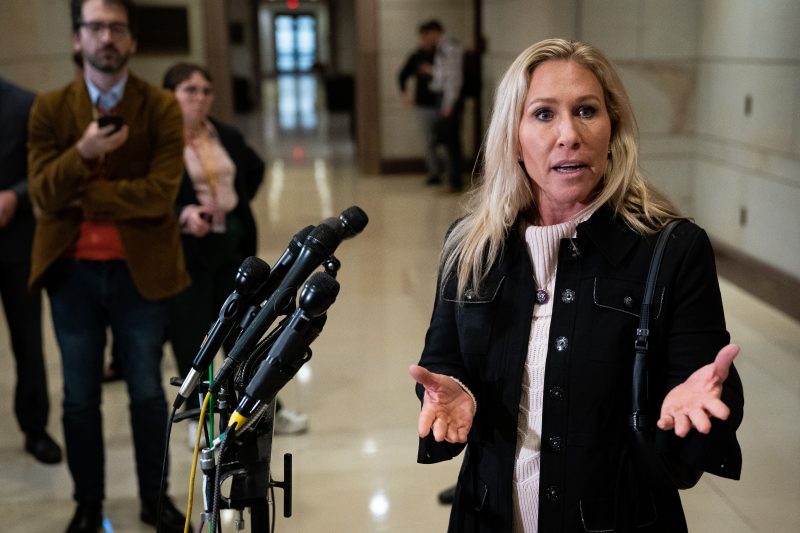We must acknowledge at the outset that Rep. Marjorie Taylor Greene’s (R-Ga.) rhetoric about a “national divorce” is neither well considered nor well meaning. Greene’s point is less that the United States should rip into two oddly constituted pieces and more that she wants to talk about how she thinks Democrats are toxic and evil. She’s working hard to backfill components aimed at making the idea seem serious and not simply a more palatable way of talking about taking up arms against the government, which she has also done.
Greene discussed the whole thing with a sympathetic Sean Hannity during his Fox News show on Tuesday night. The pair nodded along with each other as they discussed a variety of weird efforts to punish or disparage the political left.
At the outset of the conversation, Hannity endorsed one of Greene’s proposals.
“The Congresswoman has another idea as well: banning people who move from blue states to red states from voting for five years so they don’t bring their bad politics with them,” Hannity said. “I actually favor that idea.”
That Hannity thinks this is a good idea is not surprising, given its combination of lashing out at the left and superficial cleverness. But it’s immediately and obviously impractical — and hard to fit into the rest of Greene’s “proposal.”
In assessing it, let’s start with the immediate question: How many people move from blue to red states or vice versa? The Census Bureau collects data on such moves, allowing us to get a sense for the level of migration over a five-year period. The most recent full year for which the bureau has released data is 2019, before the tumult of the 2020 pandemic year. If we consider the most recent five years, here’s how migration into each state has looked.
One pattern that is immediately apparent is that red states tend to see more migration from red states and most blue states see more migration from blue ones. This is very apparent in the Northeast, where immigration from blue states is much higher than from red states over the five-year period. This is in part because people tend not to move that far, and since the Northeast is so blue, it sees more movement between blue states. In the lower Midwest, the pattern is the opposite.
There are a number of red states where more migrants come from blue states. In the mountain states, it’s common that more migrants come from blue parts of the country. That’s also the case in Florida.
You can presumably see one of the massive flaws in Greene’s idea right away. Why are so many people from blue states moving to Idaho, Montana and Wyoming? Well, in 2019, a quarter of those who moved to Idaho came from California. Is it safe to assume that those people are California liberals looking to overhaul Idaho’s conservative power structure? Or is it more likely that those are more conservative Californians looking to get away from the state’s more-liberal politics?
What Greene is creating is a disincentive for people to flee the horrible blue-state politics she abhors. She’s undercutting Arkansas Gov. Sarah Huckabee Sanders’s (R) pitch for Californians to move to her state — would you want to move somewhere that punishes you for having come from a place you agree was bad?
This isn’t what Greene or Hannity mean, of course. They’re thinking about situations like Virginia, where an influx of new residents turned the northern part of the state blue in fairly short order. What they really mean is that new Democrats arriving in states shouldn’t be allowed to vote for five years — and it seems likely that Greene’s Red America would happily pass laws restricting the franchise predicated on a person’s prior party registration.
Here we remember that this idea is theoretically predicated on a “national divorce.” So there’s a new country, Red America, and it’s letting new immigrants from Bluemerica vote legally after five years? Quite a change from Greene and Hannity’s assessment of when immigrants from outside the currently constituted United States should be allowed to vote.
Again, this is not serious in the big picture or in the details. It is an amalgam of anti-left rhetoric reworked into something passable with allies as a complex proposal. It considers no complexity, like the fact that Red America employers would be unable to recruit from the foreign land. Greene’s home state of Georgia — a blue state, per the 2020 presidential election results! — would be an island surrounded by red, with anyone hoping to move to Alabama or South Carolina or wherever disenfranchised for half a decade.
Of course, Greene doesn’t really think Georgia is a blue state since she’s eagerly reiterated Donald Trump’s false claims about election fraud. She said on Hannity (and on social media) that everyone she knows thinks the left is toxic and dangerous — an admission that tells us less about the politics of Georgia than about her chosen associations. But her point, really, is that she doesn’t want states like Georgia to go from red to blue. That’s what the five-year ban is about.
It’s hard to evaluate what would happen if the rule had been in place before 2020. Yes, we have data on moves from 2015 to 2019, but not on whether those individuals had moved to a state and then moved back out. We don’t know how many are citizens or adults, requirements for voting in federal elections anyway. But let’s assume, unfairly, that everyone who moved to a state during those five years stayed, was an adult citizen and — importantly and least defensively — voted in line with their originating state’s 2016 politics. In other words, if you came from California, then you would then have voted for Joe Biden in 2020.
What happens? Well, if only red states ban votes from new blue-state arrivals, then all of the states that flipped from Trump to Biden between 2016 and 2020 would stay in Trump’s column. It’s not hard to see why if we look at Georgia. Biden got 2.47 million votes there in 2020, winning by nearly 12,000 votes. But if we take out the 541,000 people who moved from blue states? An easy Trump win.
If we assume that blue states would reciprocate, things don’t change. Those same five states still flip from Biden to Trump, but no states flip from Trump to Biden. Why? In part because Biden won more populous states by bigger vote margins. In part, too, because blue states see more in-migration from other blue states.
If we simply imagine a blanket rule in which no one who has arrived in the past five years can vote, things get goofy. Suddenly Delaware goes for Trump in 2020, which doesn’t seem to accurately reflect how natives of the state feel about Joe Biden. Trump picks up a number of other smaller states, too, such as Maine, but larger states like Michigan go back to Biden. It’s a mess.
It’s also nonsense. It’s part of a long-standing effort to cast Democratic votes as unwelcome, tainted or invalid. Instead of complaining about urban votes after the fact, this is just advocacy of disenfranchising Democrats at the outset.
But it also reflects something that Greene and Hannity don’t want to admit. State politics are shifting as a result of population changes. That disadvantaged Trump in 2020 and likely poses a problem for Republicans moving forward. Instead of actually making compelling arguments to win over Democrats and swing voters, Greene and Hannity want to create a real-world manifestation of their rhetorical bubble and keep out anyone who would challenge their worldview.
This is not a demonstration of confidence in their position.








